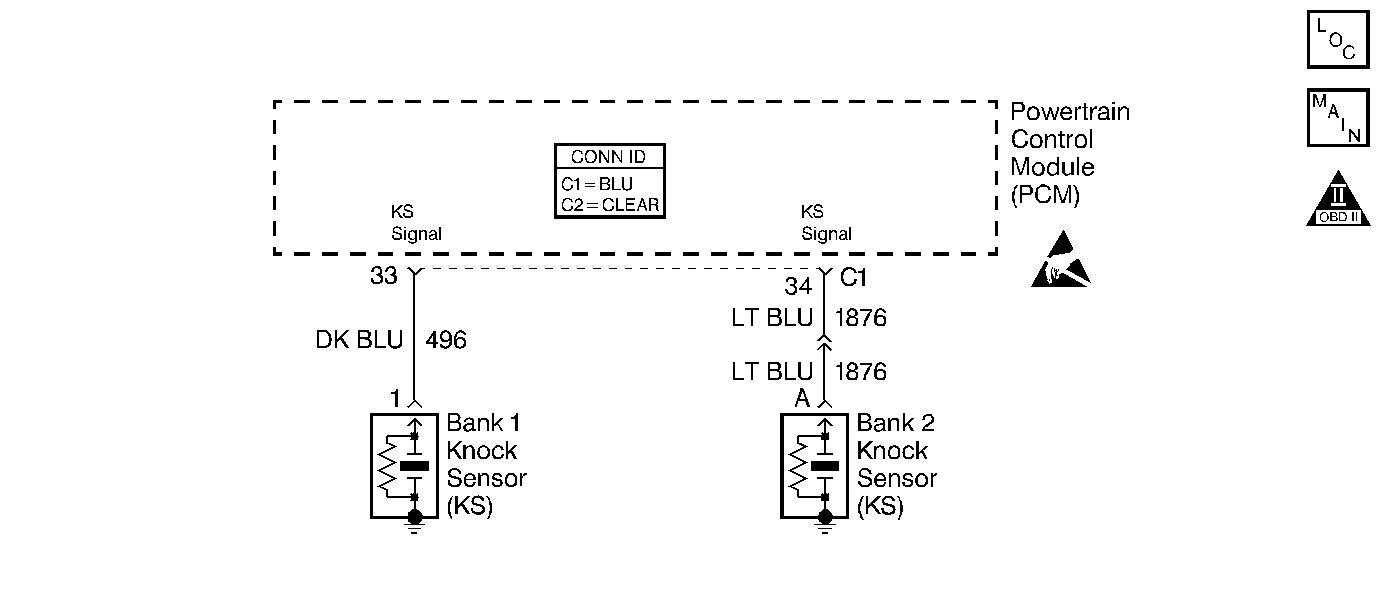
Circuit Description
The PCM contains integrated Knock Sensor (KS) Diagnostic Circuitry. Input signals from the knock sensors are used to detect engine detonation, allowing the PCM to retard Ignition Control (IC) spark timing based on the amplitude and frequency of the KS signal being received. The knock sensors produce an AC signal under all engine operating conditions. The PCM calculates an average voltage of each knock sensor's signal and takes instantaneous signal voltage readings. The PCM uses the instantaneous signal voltage readings to determine the state of the knock sensor circuitry. If the knock sensor system is operating normally, the PCM should monitor instantaneous KS signal voltage readings varying outside a voltage range above and below the calculated average voltage. If PCM detects a Knock Sensor 2 signal voltage within the calculated average voltage range, DTC P0332 will set. Refer to Knock Sensor System for further information.
Conditions for Running the DTC
| • | No TP sensor, VSS, CKP, MAF or ECT sensor DTCs set. |
| • | Engine coolant temperature is greater than 65°C (149°F). |
| • | Throttle angle is greater than 10%. |
| • | Engine load is greater than 45%. |
| • | Engine speed is between 1000 and 2500 RPM. |
| • | Engine has been running for longer than 30 seconds. |
| • | Maximum system spark retard is less than 15 degrees. |
| • | System voltage is greater than 9 volts. |
Conditions for Setting the DTC
The PCM detects a Knock Sensor 2 signal voltage within the calculated average range for 10 seconds.
Action Taken When the DTC Sets
The PCM stores conditions which were present when the DTC set as Failure Records only. This information will not be stored as Freeze Frame Records.
Conditions for Clearing the MIL/DTC
| • | The DTC becomes history when the conditions for setting the DTC are no longer present. |
| • | The history DTC clears after 40 malfunction free warm-up cycles. |
| • | The PCM receives a clear code command from the scan tool. |
Diagnostic Aids
Check for the following conditions:
| • | Poor connection at the PCM or Knock Sensor 2. |
| Inspect knock sensor 2 and PCM connectors for backed out terminals, broken locks, and improperly formed or damaged terminals. |
| • | Misrouted harness. |
| Inspect the knock sensor harness to ensure that it is not routed too close to high voltage wires such as spark plug leads. Refer to Intermittents and Poor Connections Diagnosis . |
Reviewing the Fail Records vehicle mileage since the diagnostic test last failed may help determine how often the condition that caused the DTC to be set occurs. This may assist in diagnosing the condition.
Test Description
The numbers below refer to the step numbers on the diagnostic table.
-
This verifies the malfunction is present. The scan tool will display DTC Ran=Yes and Pass=Int if the failure is intermittent. This indicates the diagnostic passed this ignition cycle and failed this ignition cycle. At this point the resistance of the knock sensors should be verified to be in the correct range. If the knock sensor resistances are correct, check the KS system wiring connections. When checking the KS system connections, start at the KS system jumper harness connector located behind the intake manifold. Then check the connections at the PCM. Refer to the wiring schematic for the correct connector and terminal. Then check the connections at the appropriate knock sensor. Failure Records data does not include the parameter KS Activity, however other parameters may aid in locating the conditions under which an intermittent occurred.
-
This test will isolate the Knock Sensor from the rest of the circuit.
-
Tap on the engine block in the location of the appropriate knock sensor.
Step | Action | Value(s) | Yes | No | ||||||
|---|---|---|---|---|---|---|---|---|---|---|
1 | Did you perform the Powertrain On-Board Diagnostic (OBD) System Check? | -- | ||||||||
|
Important: If an engine knock can be heard, repair the engine mechanical problem before proceeding with this diagnostic.
Does the scan tool indicate that this diagnostic failed this ignition? | -- | Go to Diagnostic Aids | ||||||||
Is the resistance within the specified range? | 93-107Kohms | |||||||||
Is any signal indicated while tapping on the engine near the Knock Sensor? | -- | |||||||||
5 |
Did you find and correct the condition? | -- | ||||||||
6 | Replace the Knock Sensor. Refer to Knock Sensor Replacement . Is the action complete? | -- | -- | |||||||
7 | Check the KS signal circuit for a poor connection at the PCM. Refer to Intermittents and Poor Connections Diagnosis . Did you find and correct the condition? | -- | ||||||||
8 |
Important:: Program the replacement PCM. Refer to Powertrain Control Module Replacement/Programming . Replace the PCM. Is the action complete? | -- | -- | |||||||
9 |
Does the scan tool indicate that this test ran and passed? | -- | ||||||||
10 | With a scan tool, select the Capture Info option and the Review Info option. Does the scan tool display any DTCs that you have not diagnosed? | -- | Go to the applicable DTC table | System OK |
